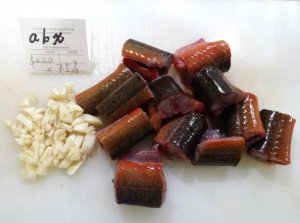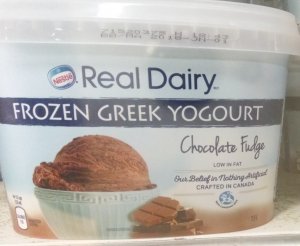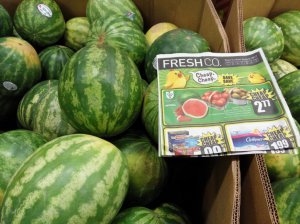Whole Foods Market and Irradiation
We believe produce and meat products can and should be packaged, transported and stored to retain maximum nutritional value without the use of irradiation. In addition, consumers and industry leaders have been adamant that irradiation is not compatible with organic food production.
What is irradiation?
Irradiation is a method of food preservation in which foods are treated with ionizing radiation from Cobalt 60, Cesium 137, X-rays, or high energy electron beams from machine sources. Irradiation is also referred to as "ionizing radiation" because it produces energy waves strong enough to dislodge electrons from atoms and molecules, thereby converting them to electrically charged particles called ions. Other terms commonly used to identify ionizing irradiation are "cold pasteurization" and "irradiation pasteurization."
Gamma rays produced from Cobalt 60 and Cesium 137 and X-rays are able to penetrate food to greater depths than electron beams, which can only penetrate a maximum of one inch below the surface of most foods (three inches if irradiated from both sides of the food). While electron beams are not produced from radioactive sources and therefore have no resultant radioactive waste, they do produce ionizing changes in foods, just as the other irradiation energy sources do.
Ionizing radiation reduces the number of disease-causing organisms in foods by disrupting their molecular structure and killing potentially harmful bacteria and parasites. However, when food is irradiated, some nutrients are destroyed and untested compounds, referred to as URPs (unique radiolytic products), may be created.
Do we need irradiation?
Recent reports of food-borne illness from pathogens such as E. coli and Salmonella have heightened the need for prevention and control of contaminated food. Public health experts note that the trend towards eating more fresh uncooked produce, combined with the increase in imported foods and reduced awareness about safe food handling practices, have contributed to the increased risk of food-borne disease in our country. As a result, many public health and government officials and trade associations have begun campaigning to promote the increased use of irradiation on our food.
Nevertheless, higher costs and a perception that consumers do not want to buy irradiated foods have made manufacturers slow to adopt irradiation. An August, 2000, report showed that only half of the nearly 11,000 adults polled by the Centers for Disease Control, United States Department of Agriculture, and the Food and Drug Administration were willing to buy irradiated beef or poultry. Only one quarter of the adults surveyed were willing to pay a higher price for irradiated foods. They cited insufficient information about irradiation and concerns about safety as the primary reasons why they would not buy irradiated meat and poultry.
The Irradiation Debate
Irradiation of food has been shown to kill or inactivate a number of food-borne pathogens such as E. coli 0157:H7, Bacillus cereus, Clostridium botulinum, Listeria monocytogenes, Salmonella, Staphylococcus aureus, Campylobacter jejuni, Cyclospora, and Toxoplasma gondii. While irradiation can kill, or substantially reduce, the number of potentially dangerous organisms in foods, it will not eradicate all pathogens.
Additionally, irradiation can only be used on a limited number of foods. Fresh produce such as lettuce, grapes, tomatoes, and cucumbers turn mushy and unpalatable. Thus, the risk from contaminated fresh produce, a major carrier of food-borne disease, cannot be fully addressed by irradiation. Understandably, not all food authorities support irradiation, and even the strongest proponents acknowledge that irradiation is no match for bad sanitation and substandard practices. Irradiation can only help control the contamination once it occurs; it cannot prevent it.
How can you tell if food has been irradiated?
The Food and Drug Administration Modernization Act of 1997 (FDAMA) has impaired consumers' ability to identify irradiated foods on store shelves. Although "treated with radiation" or "treated by irradiation" is still required to appear on foods that have been irradiated, the FDAMA, Sec. 306, amended prior labeling requirements so that the irradiation disclosure statement on food packaging can be printed in the same size type as the ingredients listings. Additionally, any foods that are not entirely irradiated are not required to print the disclosure statement on the labeling. For instance, a can of soup containing herbs that have been irradiated (as well as ingredients that have not) does not have to display this information anywhere on the label. Foods that the FDA has approved for irradiation include wheat, flour, red meat, poultry, pork, fresh shell eggs, vegetables, and spices as well as refrigerated and frozen uncooked meat, meat by-products, and certain other meat food products.
Furthermore, irradiation can only be used on a limited number of foods and does not address the larger problem of preventing contamination. Reliance on irradiation may provide a false sense of security and delay efforts to effectively clean up our food production.
More comprehensive food safety and quality strategies such as Hazard Analysis Critical Control Point (HACCP) programs can provide long-term prevention and control of food-borne illness. Other food sanitation technologies such as high pressure, pulsed light, and ozone treatment are currently under development and may provide benefits similar to irradiation without the potential hazards.
What can you do?
Take action by urging your Senators and Representatives to support prominent labeling on irradiated foods. Tell them that consumers have the right to easily discern which foods have been irradiated. Voice your opposition to legislation, such as the amendment to the FDA Modernization Act of 1997, that undermines your ability to identify irradiated foods. Be sure to practice safe food handling in your own home. Consumers can effectively reduce the risk of contamination without processes such as irradiation. In fact, sporadic cases and smaller localized outbreaks in the home and surrounding community are far more common than large publicized outbreaks. Contact the USDA Food Safety and Inspection Service (1-800-535-4555) or the FDA (1-800-FDA-4010) for more information.
We believe produce and meat products can and should be packaged, transported and stored to retain maximum nutritional value without the use of irradiation. In addition, consumers and industry leaders have been adamant that irradiation is not compatible with organic food production.
What is irradiation?
Irradiation is a method of food preservation in which foods are treated with ionizing radiation from Cobalt 60, Cesium 137, X-rays, or high energy electron beams from machine sources. Irradiation is also referred to as "ionizing radiation" because it produces energy waves strong enough to dislodge electrons from atoms and molecules, thereby converting them to electrically charged particles called ions. Other terms commonly used to identify ionizing irradiation are "cold pasteurization" and "irradiation pasteurization."
Gamma rays produced from Cobalt 60 and Cesium 137 and X-rays are able to penetrate food to greater depths than electron beams, which can only penetrate a maximum of one inch below the surface of most foods (three inches if irradiated from both sides of the food). While electron beams are not produced from radioactive sources and therefore have no resultant radioactive waste, they do produce ionizing changes in foods, just as the other irradiation energy sources do.
Ionizing radiation reduces the number of disease-causing organisms in foods by disrupting their molecular structure and killing potentially harmful bacteria and parasites. However, when food is irradiated, some nutrients are destroyed and untested compounds, referred to as URPs (unique radiolytic products), may be created.
Do we need irradiation?
Recent reports of food-borne illness from pathogens such as E. coli and Salmonella have heightened the need for prevention and control of contaminated food. Public health experts note that the trend towards eating more fresh uncooked produce, combined with the increase in imported foods and reduced awareness about safe food handling practices, have contributed to the increased risk of food-borne disease in our country. As a result, many public health and government officials and trade associations have begun campaigning to promote the increased use of irradiation on our food.
Nevertheless, higher costs and a perception that consumers do not want to buy irradiated foods have made manufacturers slow to adopt irradiation. An August, 2000, report showed that only half of the nearly 11,000 adults polled by the Centers for Disease Control, United States Department of Agriculture, and the Food and Drug Administration were willing to buy irradiated beef or poultry. Only one quarter of the adults surveyed were willing to pay a higher price for irradiated foods. They cited insufficient information about irradiation and concerns about safety as the primary reasons why they would not buy irradiated meat and poultry.
The Irradiation Debate
Irradiation of food has been shown to kill or inactivate a number of food-borne pathogens such as E. coli 0157:H7, Bacillus cereus, Clostridium botulinum, Listeria monocytogenes, Salmonella, Staphylococcus aureus, Campylobacter jejuni, Cyclospora, and Toxoplasma gondii. While irradiation can kill, or substantially reduce, the number of potentially dangerous organisms in foods, it will not eradicate all pathogens.
Additionally, irradiation can only be used on a limited number of foods. Fresh produce such as lettuce, grapes, tomatoes, and cucumbers turn mushy and unpalatable. Thus, the risk from contaminated fresh produce, a major carrier of food-borne disease, cannot be fully addressed by irradiation. Understandably, not all food authorities support irradiation, and even the strongest proponents acknowledge that irradiation is no match for bad sanitation and substandard practices. Irradiation can only help control the contamination once it occurs; it cannot prevent it.
How can you tell if food has been irradiated?
The Food and Drug Administration Modernization Act of 1997 (FDAMA) has impaired consumers' ability to identify irradiated foods on store shelves. Although "treated with radiation" or "treated by irradiation" is still required to appear on foods that have been irradiated, the FDAMA, Sec. 306, amended prior labeling requirements so that the irradiation disclosure statement on food packaging can be printed in the same size type as the ingredients listings. Additionally, any foods that are not entirely irradiated are not required to print the disclosure statement on the labeling. For instance, a can of soup containing herbs that have been irradiated (as well as ingredients that have not) does not have to display this information anywhere on the label. Foods that the FDA has approved for irradiation include wheat, flour, red meat, poultry, pork, fresh shell eggs, vegetables, and spices as well as refrigerated and frozen uncooked meat, meat by-products, and certain other meat food products.
Furthermore, irradiation can only be used on a limited number of foods and does not address the larger problem of preventing contamination. Reliance on irradiation may provide a false sense of security and delay efforts to effectively clean up our food production.
More comprehensive food safety and quality strategies such as Hazard Analysis Critical Control Point (HACCP) programs can provide long-term prevention and control of food-borne illness. Other food sanitation technologies such as high pressure, pulsed light, and ozone treatment are currently under development and may provide benefits similar to irradiation without the potential hazards.
What can you do?
Take action by urging your Senators and Representatives to support prominent labeling on irradiated foods. Tell them that consumers have the right to easily discern which foods have been irradiated. Voice your opposition to legislation, such as the amendment to the FDA Modernization Act of 1997, that undermines your ability to identify irradiated foods. Be sure to practice safe food handling in your own home. Consumers can effectively reduce the risk of contamination without processes such as irradiation. In fact, sporadic cases and smaller localized outbreaks in the home and surrounding community are far more common than large publicized outbreaks. Contact the USDA Food Safety and Inspection Service (1-800-535-4555) or the FDA (1-800-FDA-4010) for more information.








